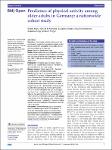Predictors of physical activity among older adults in Germany: a nationwide cohort study
Manz, Kristin
Mensink, Gert
Jordan, Susanne
Schienkiewitz, Anja
Krug, Susanne
Finger, Jonas David
Objectives: To investigate individual, interpersonal and environmental baseline factors predicting regular aerobic physical activity (PA) participation among older adults in Germany at follow-up 12 years later.
Design: Population-based cohort study.
Setting: Cluster-randomised general population sample selected based on population registry address information from 130 nationally distributed sample points collected from 1997 to 1999 and re-evaluated 12 years later from 2008 to 2011.
Participants: 1184 adults, aged 65 years or older at follow-up with complete data at baseline and follow-up, were included in the final study sample.
Outcome: measure Regular ‘aerobic PA ≥1 day/week’ assessed based on self-reported information.
Results: At follow-up, 53.2% of the participants engaged in aerobic PA ≥1 day/week. Participants aged 50 to 60 years at baseline were more likely to engage in aerobic PA ≥1 day/week than participants aged 61 to 78 years; OR 1.88, 95% CI 1.46 to 2.40. Participants with middle and high socioeconomic status (SES) were more likely to engage in aerobic PA ≥1 day/week than participants with low SES; OR middle SES 2.08, 1.33 to 3.25; high SES 3.44, 2.11 to 5.60. Participants with high social support were more likely to engage in aerobic PA ≥1 day/week at follow-up than participants with low social support; OR 1.98, 1.26 to 3.12. Furthermore, participants who engaged in leisure time PA at least once per week at baseline were more likely to engage in aerobic PA ≥1 day/week at follow-up than those who engaged less than once per week; OR 1.95, 1.46 to 2.60.
Conclusions: Several influencing factors assessed at baseline predicted regular aerobic PA participation 12 years later. These factors should be considered when planning interventions to prevent physical inactivity in older adults. There is great potential to increase aerobic PA participation in older adults in Germany, in particular among those with low SES and low social support.

